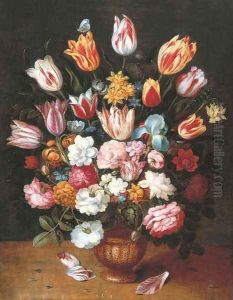Osias, The Younger Beert Paintings
Osias Beert the Younger, born in 1580, was a Flemish still-life painter active in the early 17th century, a period that witnessed the flourishing of still-life painting in the Southern Netherlands, particularly in Antwerp. He was part of a family of artists and is often confused with his more famous relative, Osias Beert the Elder, who was also a prominent still-life painter. Despite the commonality in their choice of subjects and styles, which primarily focused on still-life compositions, the younger Beert managed to carve out his own niche within this genre, contributing to the evolution of still-life painting in his time.
Beert's work is characterized by its meticulous attention to detail, rich color palette, and the intricate arrangement of objects, which often included exotic fruits, flowers, and precious items that reflected the wealth and curiosity of the Flemish society during the Age of Exploration. His paintings are not just mere representations of inanimate objects but are imbued with a sense of vitality and an appreciation for the texture and quality of the different elements he portrayed. This was a time when still-life paintings started to gain popularity for their ability to showcase an artist's skill in rendering different materials and surfaces, from the translucency of glass to the velvety surface of a peach.
The younger Beert's contribution to art history, while overshadowed by the achievements of his elder, is significant in the context of the development of still-life painting in Flanders. His works are considered important examples of early 17th-century still-life compositions, demonstrating the genre's shift from simple table settings to more complex and symbolically charged arrangements that included a wide range of objects, each carefully chosen for its visual or metaphorical qualities. Unfortunately, like many artists of his time, Osias Beert the Younger's life is not well-documented, and much of what is known about him comes from the analysis of his surviving artworks and the historical context in which he worked.
Osias Beert the Younger died in 1624, leaving behind a body of work that continues to be studied and appreciated for its beauty and historical value. His paintings are held in private collections and museums around the world, where they serve as a testament to the skill and creativity of Flemish still-life painters during this vibrant period of art history.
